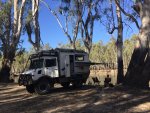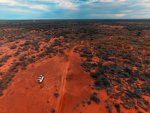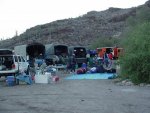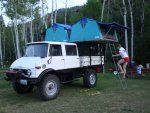Sitec
Adventurer
Here's my take on it... (and I'm not saying I'm right or wrong), but it's the reason we went with our choice...
The smaller affordable Unimogs have a short wheelbase. Add to that wasted space with a bonnet and you have little room to fit a box. If you do, you then have to watch weight and are still on slow portal axles, and if you are not careful, end up with a short, tall and possibly ungainly top heavy build... You then step up to the larger Mogs... Longer wheelbase, bigger engines and 10 stud rims. These were my second choice of build platform and there are quite a few ex Australian Army units here coming up for sale for sensible money... You still have the issue of wasted space as they are not 'cab over'. I've heard a mix of reports/complaints/issues with portal axles, oil temps, parts and overloading etc, which is why I pitted it as second option to our chosen option. Lastly... Where do you really plan to take your 8-12 tonne $100000 home on wheels... This needs serious consideration... On ariving at that bog hole, river crossing, 45 deg down hill slope, do you really need to drive there...? Mogs are truly awesome off road in the right hands. Just watching where Ian (member on here) has been in Australia with his Mog Overlander is impressive to say the least. However, I (never say never) can't see us needing to truly utilize the off-road capabilities of a Unimog, which is why I went this way......
We have purchased a Mercedes 1222a cab over truck.. (one of only a few Merc options I had available to me here in Oz... I'd have liked the slightly larger Mercedes 1831 AK). Ours is a 12 tonne 220hp unit. It has huge axles, (Hub Reduction) and the rear is capable of handling 500hp alone. Our chassis rails allow for a 6m living body that's approx 2.5m wide. It has a lazy 10.5lt V6 engine (available from 220hp to 340hp), selectable 4x4, high range, low range and front and rear diff lock. The cab tips allowing full access to the engine at all times. Being a 12 tonner, it's over engineered and should never suffer from axle failure, chassis overloading etc etc. I've used Mercedes NG, MK and SK trucks as tour coaches in Africa. The only faults I had in two years out there was a lift pimp on a 2421 V6, and a rear main leaf fail on a 1617. Both trucks were in daily use and we loved them. Quote the chassis number almost anywhere in the world and parts appear! They run 10.00 R20 or 11R22.5 tyres which are also available pretty well anywhere in the world (and at a sensible cost). I'm of the opinion a heavier simpler truck is the way to go. I totally get the love of Mogs, and think theyre brilliant, just not quite the right unit for me. Hopefully our truck will prove it's worth in the future. It's already paid for itself in the 4-5 years of ownership.
The smaller affordable Unimogs have a short wheelbase. Add to that wasted space with a bonnet and you have little room to fit a box. If you do, you then have to watch weight and are still on slow portal axles, and if you are not careful, end up with a short, tall and possibly ungainly top heavy build... You then step up to the larger Mogs... Longer wheelbase, bigger engines and 10 stud rims. These were my second choice of build platform and there are quite a few ex Australian Army units here coming up for sale for sensible money... You still have the issue of wasted space as they are not 'cab over'. I've heard a mix of reports/complaints/issues with portal axles, oil temps, parts and overloading etc, which is why I pitted it as second option to our chosen option. Lastly... Where do you really plan to take your 8-12 tonne $100000 home on wheels... This needs serious consideration... On ariving at that bog hole, river crossing, 45 deg down hill slope, do you really need to drive there...? Mogs are truly awesome off road in the right hands. Just watching where Ian (member on here) has been in Australia with his Mog Overlander is impressive to say the least. However, I (never say never) can't see us needing to truly utilize the off-road capabilities of a Unimog, which is why I went this way......
We have purchased a Mercedes 1222a cab over truck.. (one of only a few Merc options I had available to me here in Oz... I'd have liked the slightly larger Mercedes 1831 AK). Ours is a 12 tonne 220hp unit. It has huge axles, (Hub Reduction) and the rear is capable of handling 500hp alone. Our chassis rails allow for a 6m living body that's approx 2.5m wide. It has a lazy 10.5lt V6 engine (available from 220hp to 340hp), selectable 4x4, high range, low range and front and rear diff lock. The cab tips allowing full access to the engine at all times. Being a 12 tonner, it's over engineered and should never suffer from axle failure, chassis overloading etc etc. I've used Mercedes NG, MK and SK trucks as tour coaches in Africa. The only faults I had in two years out there was a lift pimp on a 2421 V6, and a rear main leaf fail on a 1617. Both trucks were in daily use and we loved them. Quote the chassis number almost anywhere in the world and parts appear! They run 10.00 R20 or 11R22.5 tyres which are also available pretty well anywhere in the world (and at a sensible cost). I'm of the opinion a heavier simpler truck is the way to go. I totally get the love of Mogs, and think theyre brilliant, just not quite the right unit for me. Hopefully our truck will prove it's worth in the future. It's already paid for itself in the 4-5 years of ownership.








